Contents
1. The concept of a process
2. Virtual Memory
3. User/Kernel Mode
4. Tap Handling
5. Segmentation
6. I/O Subsystem
1. The concept of a process
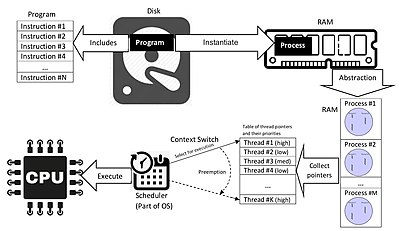
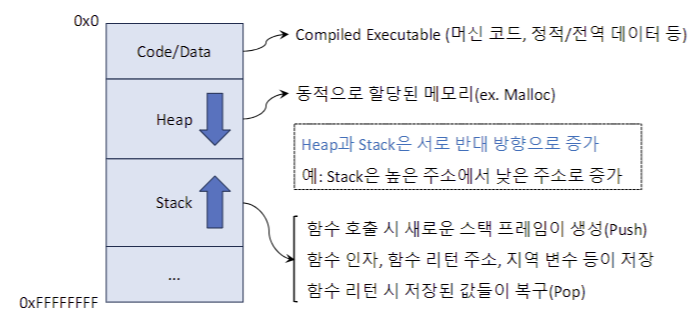
- Process
- A process is the instance of a computer program that is being executed one or many threads, which the smallest sequence of programmed instructions.
- For example, when writing a C program, you might use the compiler to turn source code into an executable(or binary). And you might run the new executable file that is a file in a machine language for a physical CPU.
- Process Memory Layout
- Each running program has its own memory layout, separated from other programs. When the program runs, the OS assigns it a virtual address space. The layout consists of a lot of segments, including:
- Executable code: Stores the machine code instructions to be executed by the processor.
- Static data: Stores statically initialized global and static variables to be used by the process.(uninitialized variables are stored in a seperate area called the BSS (Block Started by Symbol) segment.)
- Heap: Dynamic memory for programmer to allocate (e.g., malloc() or new)
- Stack: Stores local variables such as return address, procedure arguments, temporarily saved registers or locally allocated variables. (It operates on a LIFO priciple.)
- Each running program has its own memory layout, separated from other programs. When the program runs, the OS assigns it a virtual address space. The layout consists of a lot of segments, including:
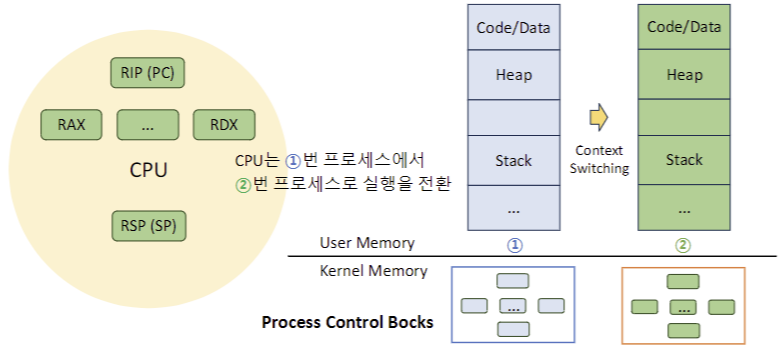
- CPU Registers
- CPU registers are used to store and manipulate data during the execution of instructions. (e.g., PC, General-Purpose Registers, SP..) CPU registers collectively represent the CPU context.
- 1) When a process is running, the CPU executes instructions sequentially from the code/data segment. The Program Counter (PC) points to the address of the instruction being executed. (e.g., EIP (x86), RIP (x64))
- 2) The CPU fetches, decodes, and executes instrunctions from the address pointed to by the PC. (e.g., RAX, RBX, RCX, RDX, ... (x64))
- 3) The CPU uses General-Purpose Registers to store data required for operations.
- 4) After an operation, the Stack Pointer (SP) points to the top address of the stack, which is used for storing data in memory.
- CPU registers are used to store and manipulate data during the execution of instructions. (e.g., PC, General-Purpose Registers, SP..) CPU registers collectively represent the CPU context.
- Context Switching
- In a multitasking operating system, multiple processes or threads can run concurrently. However, the CPU can only execute instructions from a single process at any given time. This limitation necessitates the need for context switching.
- Context Switching refers to the process of changing focus or shifting attention from one task or activity to another.
- The OS saves the current state of the executing process or thread, including its PC, SP, and other relevant registers. It then loads the saved state of the next process or thread that needs to be executed.
- The OS temporarily stores data structures of the current process in a Process Control Block (PCB).
2. Virtual Memory
Virtual Memory is virtual or logical address that allocated to a process's memory for the CPU to reference. It is not a physical address that includes actual instruction or data and typically starts at address 0 for convenience.
- Physical Memory, also known as RAM, is the hardware component that stores data and instructions that can be accessed directly by the processor.
- The CPU requires Virtual Memory to access cade and data segements efficiently. On the other hand, hardware components such as RAM rely on Physical Memory to fetch and store data, translating Virtual Memory into Physical Memory when needed.
- Virtual Memory enalbes the system to use more memory than physical memory by creating a virtual address space that maps to the physical address space using a mechanism called paging
- Paging is the process of dividing the virtual and physical memory into fixed-size units called pages, typically 4KB per page.
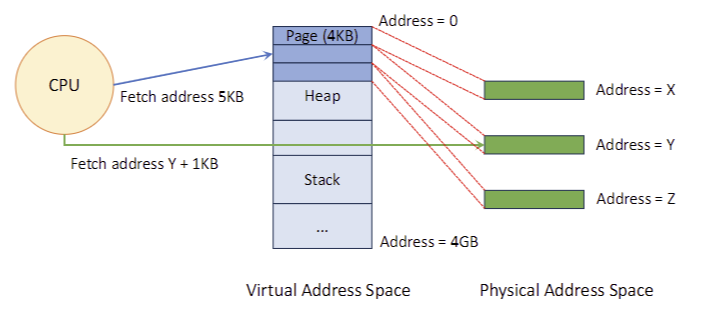
1) Fetch address 5KB (Virtual Address Space): When the CPU attempts to access the Virtual address at 5KB, the address is translated into the corresponding physical address (e.g., address Y) through the page table. This translation allows the CPU to fetch the data stored in physical memory.
2) Fetch address Y + 1KB (Physical Address Space): When accessing 5KB in the virtual address space, the page offset is calculated relative to the second page.

The page table stores the physical page numbers corresponding to the logical page numbers. When the OS allocates memory to a process, it createsa a page table, and the MMU is used for address translation.
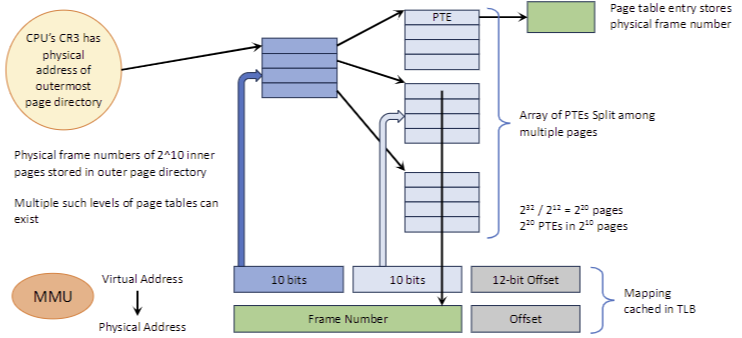
- The MMU (Memory Management Unit) references the page table and translates virtual addresses into physical addresses. The MMU uses the CR3 register for memory translation, storing the position of the page table for the currently executing process. (The CR3 register is reset during context switching)
- Recently translated addresses are stored in the TLB cache within the MMU.
- iTLB (for instruction)
- L1 dTLB, L2 dTLB (for data)
A Hierarchical(Multi-level) Page Table is an architecture designed for efficient management of large memory spaces. It divides the page table into multiple levels, with each level poiting to the next, ultimately mapping virtual pages to physical pages through PTEs (Pate Table Entries). The page table is stored in memory as smaller chunks to reduce memory overhead.
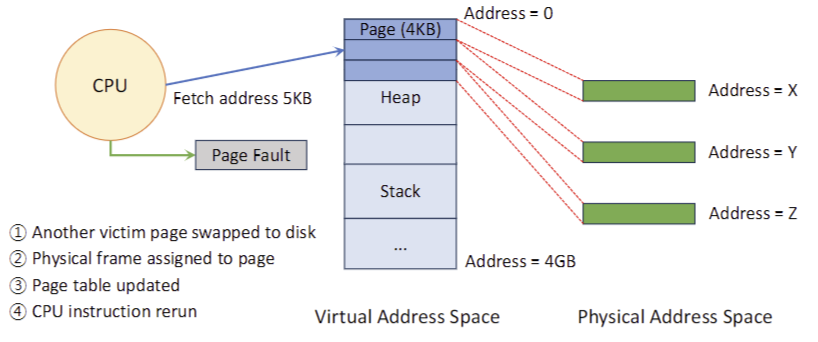
A Page fault occurs when a program attempts to access data or code that is in its address space but is not currently located in the system RAM.
- A page fault is a critical event in which a program try to attempts to access data or code that is not currently available in the physical memory (main memory).
3. User/Kernel Mode
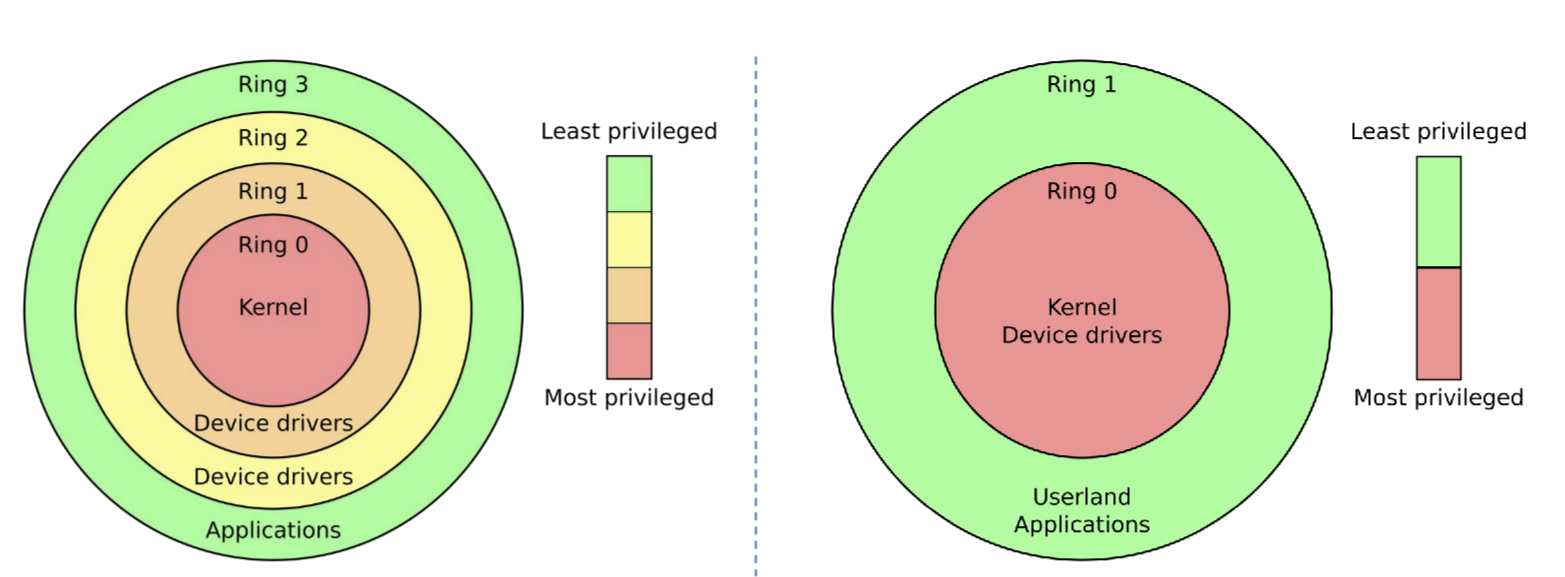
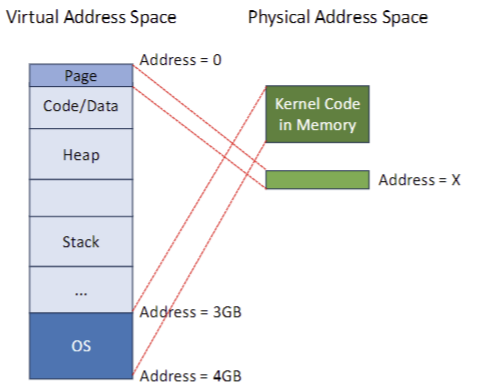
4. Trap Handling

5. Segmentation
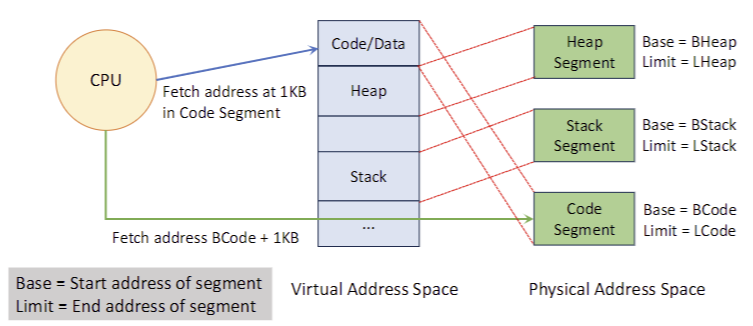

Reference
https://d3s.mff.cuni.cz/files/teaching/nswi004/text/ch03s02s01.html
3.2.1. Process Memory Layout
3.2.1. Process Memory Layout A typical process runs within its own virtual address space, which is distinct from the virtual address spaces of other processes. The virtual address space typically contains four distinct types of content: Executable code. T
d3s.mff.cuni.cz
https://courses.grainger.illinois.edu/cs225/fa2023/resources/stack-heap/
CS 225 | Stack and Heap Memory
When a program is running, it takes up memory. Sometimes we are not even aware of the memory being allocated. In fact, every time you create a new variable, your program is allocating more memory for you to store that variable. This article focuses on two
courses.grainger.illinois.edu
What is a Register in a CPU and How Does it Work?
Registers are essential components in modern day computing with their purpose of storing data in the CPU for quick processing. Learn more.
www.totalphase.com
https://startup-house.com/glossary/context-switching
Context Switching Demystified
A concise guide to understanding the critical role and implications of context switching in computing.
startup-house.com
https://www.linkedin.com/advice/0/what-difference-between-virtual-memory-physical-7ar3f
What is the difference between virtual memory and physical memory?
Learn the difference between virtual memory and physical memory, how they work together, and how to optimize and monitor them.
www.linkedin.com
https://www.geeksforgeeks.org/page-fault-handling-in-operating-system/
Page Fault Handling in Operating System - GeeksforGeeks
A Computer Science portal for geeks. It contains well written, well thought and well explained computer science and programming articles, quizzes and practice/competitive programming/company interview Questions.
www.geeksforgeeks.org
'Study > Cloud Computing' 카테고리의 다른 글
| [Cloud] Techniques to Design Virtualization (1) (0) | 2024.12.12 |
|---|---|
| [Cloud Security] Container Security (0) | 2024.12.07 |
| [Cloud Security] Introduction to Cloud Security (0) | 2024.12.02 |
| Monitor and Manage Google Cloud Resources (6) | 2024.09.22 |
| [Cloud] 쿠버네티스 실습 (0) | 2024.05.13 |



